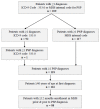Epidemiology of Progressive Supranuclear Palsy: Real World Data from the Second Largest Health Plan in Israel
- PMID: 36138862
- PMCID: PMC9496895
- DOI: 10.3390/brainsci12091126
Epidemiology of Progressive Supranuclear Palsy: Real World Data from the Second Largest Health Plan in Israel
Abstract
Progressive supranuclear palsy (PSP) is a rare and fatal neurodegenerative movement disorder and no disease modifying therapy (DMT) is currently available. This study aims to assess the epidemiology of PSP in Israel and to describe its clinical features. This retrospective analysis identified patients with PSP between 2000 and 2018 over the age of 40 years at first diagnosis (index date). We identified 209 patients with ≥1 diagnosis of PSP. Of those, 88 patients satisfied the inclusion criteria with a mean age at diagnosis of 72 years (SD = 8) and 53% were female. The 2018 prevalence and incidence rates were 5.3 and 1 per 100,000 persons, respectively. Median survival time was 4.9 years (95% CI 3.6-6.1) and median time from initial symptom to diagnosis was 4.2 years. The most common misdiagnoses were Parkinson's disease, cognitive disorder and depression. The present study demonstrates that the clinic-epidemiological features of PSP in Israel are similar to PSP worldwide. In light of PSP's rarity, investigation of PSP cohorts in different countries may create a proper platform for upcoming DMT trials.
Keywords: clinical features; future disease modifying trials; incidence; natural history; prevalence; progressive supranuclear palsy; real world data.
Conflict of interest statement
The authors Y.B., T.G. and G.C. declare no conflict of interest. X.Y., Z.J., M.G.-J. and R.C. are employees of AbbVie and may own stocks of AbbVie. The study was funded by AbbVie. The design and study conduct were performed in collaboration with AbbVie and Maccabi healthcare services, in addition to their participation in the interpretation of the data, review, and approval of the publication. No honoraria or payments were made for authorship.
Figures




Similar articles
-
Progressive supranuclear palsy's economical burden: the use and costs of healthcare resources in a large health provider in Israel.J Neurol. 2023 Aug;270(8):3770-3778. doi: 10.1007/s00415-023-11714-1. Epub 2023 Apr 17. J Neurol. 2023. PMID: 37069439 Free PMC article.
-
Disease course and treatment patterns in progressive supranuclear palsy: A real-world study.J Neurol Sci. 2021 Feb 15;421:117293. doi: 10.1016/j.jns.2020.117293. Epub 2020 Dec 25. J Neurol Sci. 2021. PMID: 33385754
-
Sensitivity and Specificity of Diagnostic Criteria for Progressive Supranuclear Palsy.Mov Disord. 2019 Aug;34(8):1144-1153. doi: 10.1002/mds.27619. Epub 2019 Feb 6. Mov Disord. 2019. PMID: 30726566 Free PMC article.
-
Effectiveness of allied health therapy in the symptomatic management of progressive supranuclear palsy: a systematic review.JBI Database System Rev Implement Rep. 2016 Jun;14(6):148-95. doi: 10.11124/JBISRIR-2016-2002352. JBI Database System Rev Implement Rep. 2016. PMID: 27532657 Review.
-
"Parkinson's disease" on the way to progressive supranuclear palsy: a review on PSP-parkinsonism.Neurol Sci. 2021 Dec;42(12):4927-4936. doi: 10.1007/s10072-021-05601-8. Epub 2021 Sep 17. Neurol Sci. 2021. PMID: 34532773 Review.
Cited by
-
Systematic review of phenotypes in McLeod syndrome and case report of a progressive supranuclear palsy in a female carrier.Orphanet J Rare Dis. 2024 Aug 25;19(1):312. doi: 10.1186/s13023-024-03309-4. Orphanet J Rare Dis. 2024. PMID: 39183347 Free PMC article.
-
Progressive supranuclear palsy's economical burden: the use and costs of healthcare resources in a large health provider in Israel.J Neurol. 2023 Aug;270(8):3770-3778. doi: 10.1007/s00415-023-11714-1. Epub 2023 Apr 17. J Neurol. 2023. PMID: 37069439 Free PMC article.
-
The prevalence and incidence of progressive supranuclear palsy and corticobasal syndrome: a systematic review and meta-analysis.J Neurol. 2023 Sep;270(9):4451-4465. doi: 10.1007/s00415-023-11791-2. Epub 2023 Jun 8. J Neurol. 2023. PMID: 37289323 Free PMC article.
-
Toward an animal model of Progressive Supranuclear Palsy.Front Neurosci. 2024 Oct 3;18:1433465. doi: 10.3389/fnins.2024.1433465. eCollection 2024. Front Neurosci. 2024. PMID: 39420986 Free PMC article. Review.
-
New Perspectives in Radiological and Radiopharmaceutical Hybrid Imaging in Progressive Supranuclear Palsy: A Systematic Review.Cells. 2023 Dec 6;12(24):2776. doi: 10.3390/cells12242776. Cells. 2023. PMID: 38132096 Free PMC article. Review.
References
-
- Stang C.D., Turcano P., Mielke M.M., Josephs K.A., Bower J.H., Ahlskog J.E., Boeve B.F., Martin P.R., Upadhyaya S.G., Savica R. Incidence and trends of progressive supranuclear palsy and corticobasal syndrome: A population-based study. J. Parkinson’s Dis. 2020;10:179–184. doi: 10.3233/JPD-191744. - DOI - PMC - PubMed
Grants and funding
LinkOut - more resources
Full Text Sources
Miscellaneous

